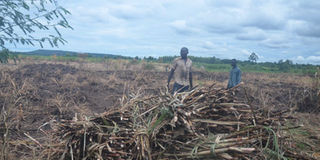Sugarcane cannot expose Busoga to famine - experts

Reap. Farmers harvest their sugarcane in Jinja District. PHOTO BY TAUSI NAKATO
What you need to know:
In 2011 and 2012, some districts in Busoga Sub-region, including Namutumba, registered cases of food insecurity and malnutrition, which left close to 20 children dead and more than 100 families affected as farmers were hiring out their land for sugarcane growing.
Although some leaders have cited sugarcane growing as one of the causes of famine in Busoga Sub-region, experts say there is no evidence to justify this.
The experts made the remarks during a training of statisticians on data collection on food security situation in Uganda that was organised by the United Nations Food and Agriculture Organisation (FAO) in Jinja District at the weekend.
Mr Amos Mpungu, the senior statistician in the Ministry of Agriculture, Animal Industry and Fisheries (MAAIF), said the issue of food security is about availability and accessibility, not about growing a certain type of crop.
“The issue of food security is about availability and accessibility, you may not be able to grow food but have resources to access food and as long as it is available, it is accessible,’’ he said.
Mr Mpungu added that as a ministry, they are planning to set up agriculture zoning where they will identify which type of crops grow best in a particular area.
“If matooke is grown in Mbarara District, it doesn’t have to be grown in Busoga but a person in Busoga can be able to access that food.
“And if sugarcane can only grow well in Busoga and produce enough money for them, let the people grow it as long as they can get Irish potatoes from Kapchorwa District and be able to have food,’’ he said.
Ms Flavia Naiga Ouma, the senior statistician in Uganda Bureau of statistics (Ubos), said Busoga Sub-region is not on the list of regions that are likely to face severe famine.
“The fear of overgrowing sugarcane and abandoning food is not an indication that Busoga Sub-region is likely to face famine. If someone grows sugarcane and has the money, then they can go and purchase food,’’ she said.
“Famine in Karamoja is because of the critical situation of the climate which is not favourable for agriculture. They are able to grow only one crop (sorghum) and when it rains, it is washed away and when it doesn’t rain, the crops dry, which is not the case with Busoga,’’ she explained.
Mr Patrick Kayemba, the chairperson of Iganga District, warned farmers against hiring out all their land for sugarcane growing without sparing some for food crop farming.
Mr Robert Ziribasanga, the chairperson of Buyende District, said the competition for land is likely to cause famine. “Of 100 acres, you can use 99 per cent for growing sugarcane, which is likely to cause scarcity of food, but if the price of sugarcane is good, you can use the money to buy food,’’ he said.
Mr James Shilaku, the Mayuge Resident District Commissioner, said sugarcane should be regulated.
“As Mayuge, we have by-laws that regulate sugarcane growing to prevent shortage of food.
“If a farmer has five acres, he is supposed to use two for food security and the remaining three for sugarcane. We noticed that people are hiring out land without sparing any for growing food crops yet sugarcane takes eighteen months to mature,’’ he said.
Records
Statistics from Busoga Sugarcane Out-growers Association indicate that Busoga Sub-region has 20,000 farmers who grow sugarcane on a large scale and supply it to five millers in the sub-region.
In 2011 and 2012, some districts in Busoga Sub-region, including Namutumba, registered cases of food insecurity and malnutrition, which left close to 20 children dead and more than 100 families affected as farmers were hiring out their land for sugarcane growing.


